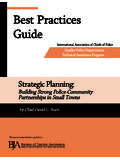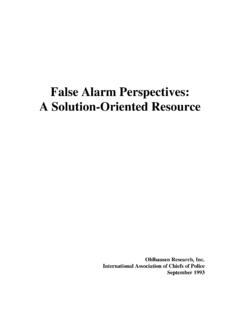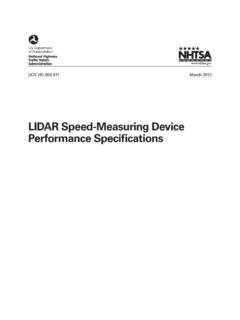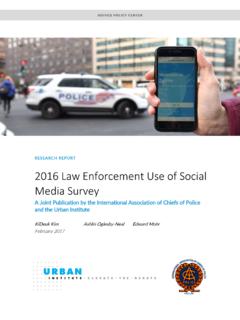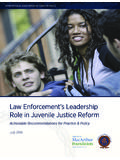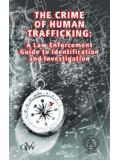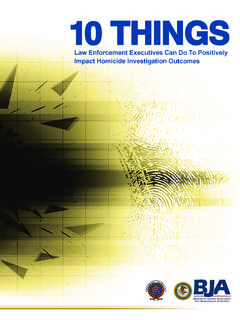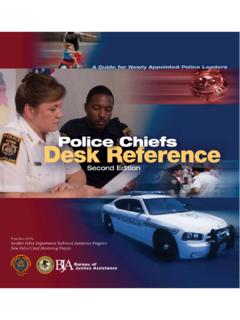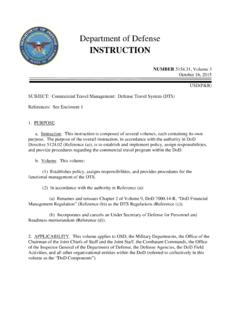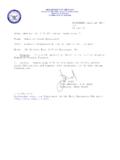Transcription of Best Practices Guide - International Association of …
1 DDeevveellooppiinngg aa PPoolliiccee DDeeppaarrttmmeennttPPoolliiccyy--PPrroo cceedduurree MMaannuuaallbbyy CChhiieeff DDwwaayynnee OOrrrriicckkSSmmaalllleerr PPoolliiccee DDeeppaarrttmmeennttss TTeecchhnniiccaall AAssssiissttaannccee PPrrooggrraammBJABB uurreeaauu ooff JJuussttiiccee AAssssiissttaanncceeOffice of Justice Programs Department of JusticeIInntteerrnnaattiioonnaall AAssssoocciiaattiioonn ooff CChhiieeffss ooff PPoolliicceeThis project supported by a grant from: BBeesstt PPrraaccttiicceessGGuuiiddeeBest Practices Guide for Developing a Police Department Policy-Procedure Manual By Chief W. Dwayne Orrick, Cordele, Georgia Police Department Introduction This Guide has been designed to assist police agencies in smaller communities with the development and revision of their policy-procedure manuals.
2 The policy and procedures manual is the foundation for all of the department s operations. When properly developed and implemented, a policy-procedure manual provides staff with the information to act decisively, consistently, and legally. It also promotes confidence and professional conduct among staff. Service delivery by agencies in smaller communities is often more responsive than departments in larger communities due to knowledge of the community and partnerships within the community. In addition, officers working in smaller agencies must be prepared for the same challenges and situations as their colleagues in larger organizations.
3 The only real difference between large and small is the degree of specialization in job assignments in smaller departments. Smaller agency officers are generalists, often seeing the case through from start to finish. Because of this, officers in smaller departments are provided more latitude to perform their jobs and are not locked into the same routine every day, allowing for more growth, job enhancement and satisfaction for the employees of these departments. Therefore, policies and procedures for smaller agencies must be as thorough and complete as in their larger counterparts.
4 The remainder of this Guide will focus on the process of developing a manual in smaller departments. It will explore the general rules for developing policies, how to form a policy committee, sources of information, how to organize the manual, steps for writing a policy, implementing a new policy, and for compliance inspections. Definitions Organizations call their policy and procedures manual different names policy and procedures, operations manual, standard operating procedures. Regardless of the name, the document provides staff with the guidance necessary to perform department operations.
5 Before outlining the process for developing an operations manual, it is necessary to provide a baseline of terminology. Several terms will be used during the development of a manual. It is necessary to distinguish between each: Standard - Guidelines or performance requirements that establish benchmarks for agencies to use in developing the organizational structure and measuring its service delivery system. Policy - A course or line of action adopted and pursued by an agency that provides guidance on the department s philosophy on identified issues. Procedure - A detailed description of how a policy is to be accomplished.
6 It describes the steps to be taken, the frequency of the task, and the persons responsible for completing the tasks. - 1 - general Orders - Written directives related to policy, procedures, rules and regulations involving more than one organizational unit. general orders typically have a broad statement of policy as well as the procedures for implementing the policy. Special Orders - Directives regulating one segment of the department or a statement of policy and procedure regarding a specific circumstance or event that is temporary in nature. Personnel Orders - Announcements of changes in status of personnel such as transfers or promotions.
7 Rules and Regulations - Procedures that apply each and every time a situation occurs with specific guidelines for staff to follow. Rules and regulations usually proscribe specific behavior that will result in employees being disciplined for failing to follow the guidelines Employee Handbook - Manual provided by the governing authority that introduces employees to the organization, its benefits/compensation package, and an abbreviated listing of policies. Rules for Effective Manual Development and Implementation When developing operational policy and procedures, several general principles should be remembered.
8 First, the operations manual should be comprehensive, providing staff with direction and guidance for all aspects of the department s operations. Second, the manual should be clearly written and easy to use. Third, the manual should be consistent with and mirror the organizational philosophy, legal requirements and applicable standards. Fourth, staff should be involved in the development of the manual and kept informed of any changes. Fifth, staff should receive adequate training and participate in open, frank discussions about the policy and the reasons for its requirements. Sixth, the operations manual should be considered a living document.
9 Routine inspections and reviews should be completed to ensure compliance with its directives so that the manual remains Seventh, The manual should reflect and incorporate accepted state and national best Practices , for example, model policies like those developed by the IACP s National Law Enforcement Policy Center or other law enforcement organization s general guidelines for policy-procedure manuals as developed by CALEA (Commission on Accreditation for Law Enforcement), state law enforcement associations and others. Formation of the Policy Committee Developing a policy manual is a critical undertaking. One of the first tasks to be completed is the selection of a policy project coordinator.
10 The selection of the proper person for this position is critical to the success of the development and implementation of the operations manual. In most agencies, this appointment is not a full-time assignment. Instead, the person must complete these responsibilities in addition to their current duties. As the leader, the policy project coordinator must have the authority, knowledge, and motivation to make assignments, draft policies, coordinate meetings, and complete the process. In addition, the coordinator must have sufficient administrative or clerical support to expedite the development process.
